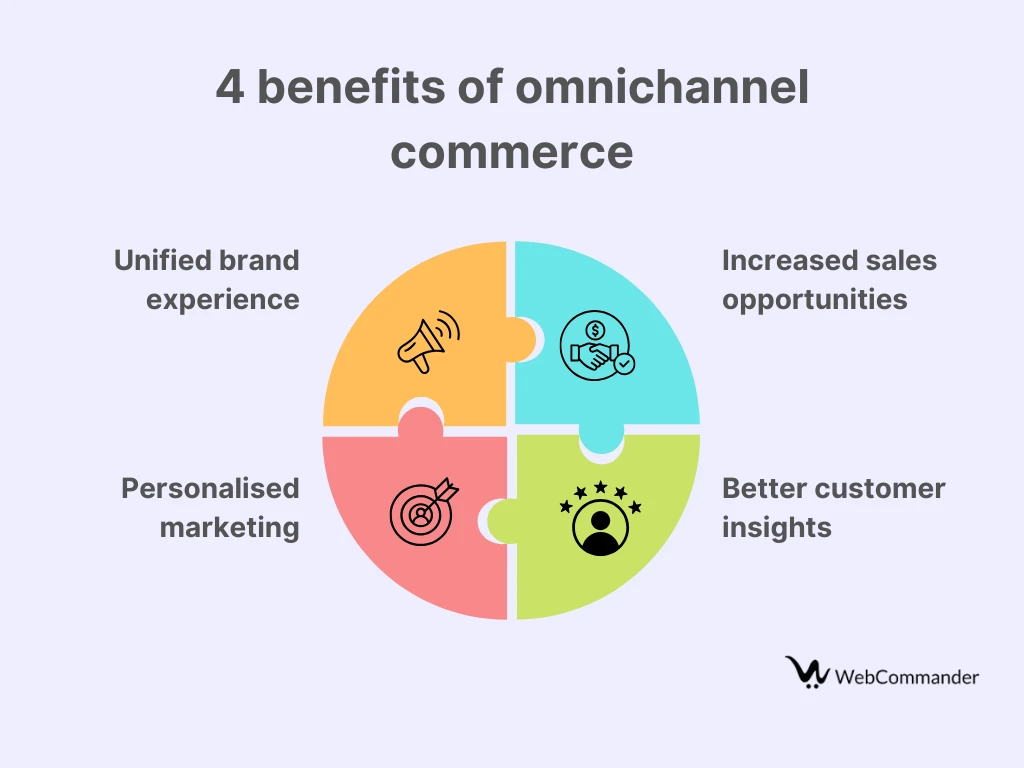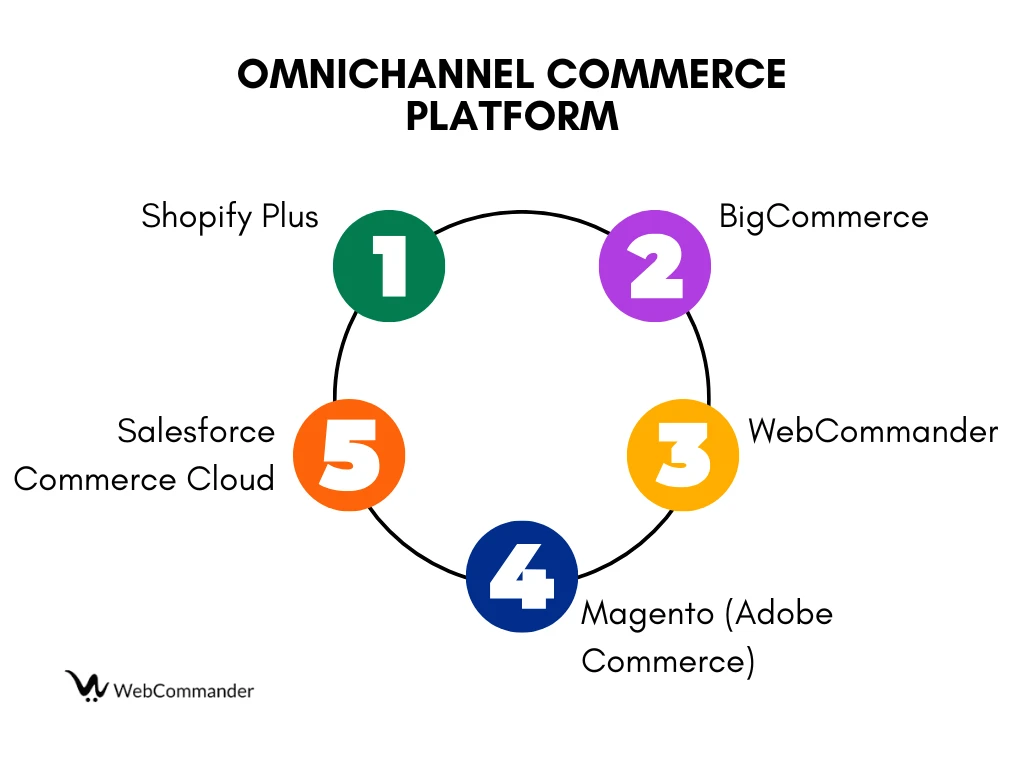What Is Omnichannel Commerce? 7 Key Strategies for Business Success
Whenever you make an online purchase, you just don't click 'buy' immediately after the first time you see a product, right?
Instead, you browse it first, then think it over, and later check it out again if you spot it later in another social media ad.
Today's customer journey works exactly like this- rarely linear but a mix of touchpoints across devices and platforms. That is why modern businesses think beyond single-channel selling and need to take a connected approach that unites all channels into one seamless experience. That is exactly what omnichannel commerce delivers.
What is omnichannel ecommerce?
It is an ecommerce sales approach where a business uses multiple channels- online, mobile, social media, marketplaces and more- and provides customers a unified experience across all channels.
In short, it is a fully integrated approach that encompasses all channels from brick-and-mortar stores to online stores and everything in between. Here, all the channels are connected and share the same data. And the goal is to make the user experience hassle-free.
For example, a customer can browse any product on their phone and add it to the cart and then later complete the purchase on their laptop without losing the progress.
Omnichannel vs multichannel ecommerce
Multichannel ecommerce is a strategy that businesses use to sell their products on multiple channels, where each platform operates independently of the others. The main purpose is to have a presence on as many channels as possible rather than creating a consistent experience across every channel.
Omnichannel ecommerce focuses on integrating all channels. Businesses use this to provide a consistent and unified shopping experience through the company's messaging, branding, pricing, shopping experiences and more.
Check out our blog to learn more about the differences between omnichannel and multichannel marketing.
4 benefits of omnichannel commerce
Here are some major benefits of creating an omnichannel commerce strategy.

1. Unified brand experience
Omnichannel commerce ensures brand consistency through identity, messaging and service quality on each and every platform. It benefits the business in building trust, strengthening brand recognition and making the shopping journey feel smooth and connected.
2. Personalised marketing
In an omnichannel scenario, businesses collect and integrate customer data from all channels and create tailored marketing campaigns based on individual preferences and buying behaviours. This helps in increasing engagement, boosting relevance and encouraging repeat purchases.
3. Increased sales opportunities
Being accessible across multiple connected channels allows customers to choose how and when they shop. This eliminates barriers to purchase, boosting more transactions, and capturing a wider audience, which leads to higher conversion rates and revenue growth.
4. Better customer insights
Omnichannel ecommerce benefits businesses by creating a complete view of customer behaviour by combining both online and offline interactions. This overall understanding allows businesses to make informed decisions about marketing strategies, product offerings, and customer service improvements.
7 key strategies to build seamless omnichannel success
1. Set clear business goals
Before you end up investing in tools, marketing campaigns or channel integration, you need to be sure about what you want your omnichannel ecommerce strategy to accomplish. You have to have a clear purpose. Think beyond the "I want to sell more" vision, consider how you want to grow and what success will look like.
For example, you can aim to boost customer retention by providing a smoother cross-channel experience. Or you can target to grow sales through online-to-offline (O2O) shopping options like Buy Online, Pick Up In-Store.
Ask yourself these questions:
- What are you trying to achieve?
- Why does this matter to your business?
- How can you measure success?
2. Segment your customer base
In today's omnichannel world, one-size-fits-all marketing no longer works. Customers want personalised experiences that match perfectly with their preferences, behaviours and needs.
You can divide your overall customer base into distinct groups depending on shared characteristics such as location, age, gender, browsing patterns, purchase history, interests and more. For example, you can do channel-based segmentation by tracking which platforms and devices customers use the most, whether it is email, social media or in-store visits.
Once you have defined segments, you can use them to create personalised marketing campaigns while aligning your customer service and support depending on the segment's preferred communication style.
3. Map the customer journey
In omnichannel ecommerce, try to understand how customers move from discovery to purchase. Understanding customer journey is all about identifying every touchpoint where the customer interacts with your brand, whether online or offline. This is important because you can easily spot where customers drop off or face issues. You will also know exactly when and where to send a message or offer.
Collect information from all touchpoints, including analytics, CRM, POS systems and customer feedback, while mapping the customer journey. Try to identify their preferred channels, like where they start, continue and end their journey. Understand their emotions and motivations while looking for breaks in the experience.
This way, you can create a blueprint of your customer's journey that will show how exactly your customers shop with you.
4. Develop a unified channel strategy
Omnichannel ecommerce is more about just being present on multiple platforms; it is about making all the channels work together as a single cohesive system. With a unified channel strategy, you can guarantee the same level of service, consistency and connection across every channel.
From showcasing the same product details, pricing and promotions everywhere to managing everything, including inventory, pricing and other data in one place, it can benefit a business in many ways.
5. Integrate data, systems and technology
Integration is the backbone for omnichannel success. If you integrate data, systems and technology, it will ensure that every channel shares the same real-time information. It will also create a solid foundation for all other omnichannel strategies.
As some best practices, you can pick technology platforms that support open APIs so that they can easily connect with other tools. Also, you can work with integration middleware or platforms or consider using cloud-based solutions to ensure accessibility and real-time syncing.
6. Ensure consistent branding and customer service
In an omnichannel scenario, customers don't just separate your brand into 'online' and 'offline' versions. They consider your business as one brand. So, if they find consistency in branding and customer service, it will build trust that will make them come back.
Use the same logo, colour palette and typography across all channels. Also, maintain the tone of voice in ads, website copy, emails and social media captions. If you offer any discounts or promotions, align those across platforms to avoid any confusion or frustration. Make sure to equip your team with a shared view of the customer's history.
7. Adopt an agile and adaptive approach
Don't go for the 'sell it and forget it' strategy. As everything is changing constantly, from customer behaviour to technology to market trends, your business needs to evolve with them as well. Try to adopt an agile and adaptive approach by reviewing the performance regularly, testing new ideas and modifying things quickly.
Track your performance data to find out what the customers are saying. Always test new marketing channels, promotions and technologies, as well as keep your eye on emerging tools and competitor strategies.
What are the 4 pillars of omnichannel?
Here are the four pillars of omnichannel that you can consider as the core elements that your business needs.
Personalisation: Tailoring offers, messages, and shopping experiences, focusing on unified customer data to make every interaction relevant and engaging.
Cross-channel engagement: Enabling customers to get connected with your brand across multiple platforms- online, offline, mobile, and social- while keeping the experience consistent.
Visibility: Ensuring real-time information regarding products, inventory, and customer activity is available across all channels for both the business and the customer.
Optimisation: Continuously improving processes, technology, and strategies based on insights and performance data to enhance customer satisfaction and business results.
What are the 4 C's of omnichannel?
Consistency, Convenience, Communication and Collaboration- consider these as the key elements that make up the 4C of omnichannel.
Consistency: A consistent brand message, look, and feel across all channels.
Convenience: Smooth, flexible shopping options that perfectly fit customer preferences.
Communication; Clear, relevant, and timely engagement at each and every touchpoint.
Collaboration: Teams and partners working together to ensure a connected, high-quality customer experience.
4 challenges with omnichannel ecommerce?
Omnichannel ecommerce come with some challenges that businesses must overcome.
Here are some common ones:
1. Integrating both online and offline data
Connecting all the information from in-store and online sales to see the full picture of each customer is the most common challenge that businesses face. Without it, companies might end up having duplicated or incomplete information.
2. Handling inventory
As products are sold through various places, it gets tough to track the amount of stock that is available in each place. To overcome this, businesses require a system that updates inventory in real time and coordinates stock across all channels.
3. Maintaining consistency
It turns out to be a great challenge to make sure everything matches perfectly across all the channels. Otherwise, if the customer finds an inconsistency, it will confuse them. To fix this, companies need strong coordination between teams and systems.
4. Handling orders and returns
Managing all options, including deliveries, pickups, and returns across channels, can get very complicated. If these cannot be handled well, it will lead to delays, lost packages or unhappy customers.
5 Omnichannel commerce platform

Shopify Plus: A powerful and scalable platform that comes with built-in omnichannel features like POS integration, multi-channel selling, and unified inventory management.
BigCommerce: It is popularly known for its flexibility and strong multi-channel capabilities. It offers seamless integration with marketplaces, social media, and physical stores.
WebCommander: This ecommerce platform is designed specifically for B2B and omnichannel retail, offering flexible store management, integrated inventory, and multi-channel selling capabilities.
Magento (Adobe Commerce): It is a highly customisable and robust platform. It supports complex omnichannel setups with extensive third-party integrations and advanced inventory tools.
Salesforce Commerce Cloud: This platform offers a unified commerce solution that combines ecommerce, marketing, and customer service for a seamless omnichannel experience.
Some omnichannel ecommerce insights
- Around 7 out of 10 retail shoppers use multiple channels while shopping. (Source)
- Before visiting a physical store 83% of shoppers research online, while 72% of shoppers use their smartphones to compare prices or read reviews when shopping in-store. (Source)
- Companies that implement effective omnichannel customer engagement strategies retain, on average, around 89% of their customers. (Source)
- Businesses that have adopted omnichannel strategies experience 91% higher year-over-year customer retention rates compared to businesses that don't. (Source)
- The global omnichannel retail solutions market size is projected to reach USD 17.92 billion by 2030, growing at a CAGR of 13.6% from 2022 to 2030. (Source)
Conclusion
Omnichannel retail is not just about adding more ways for the customer to shop; rather, it is about changing the whole shopping experience. And more and more retailers are now embracing this shift as they see stronger customer loyalty and higher sales.
Omnichannel setting is what the standard customers expect today. So, create a shopping journey where your customers will feel understood, valued and connected.




![How to Start an Ecommerce Business in Australia [2023 Guide]](/template/5731a701/images/resource-blog-right-img1.png)





